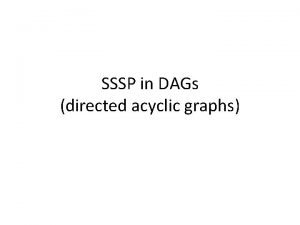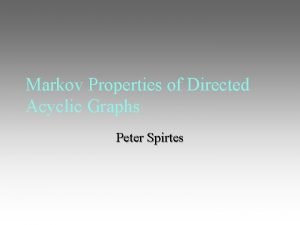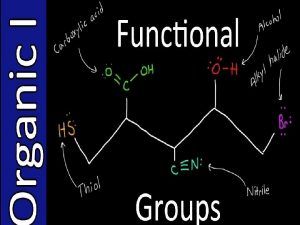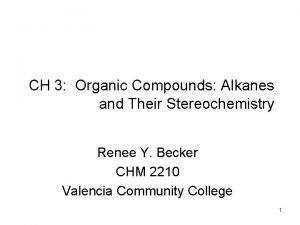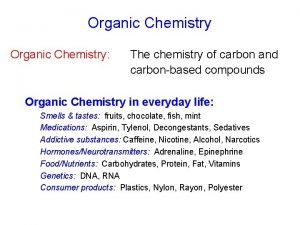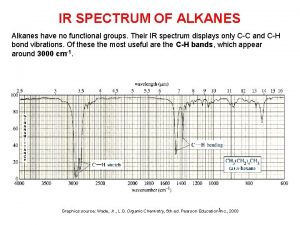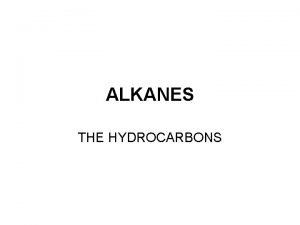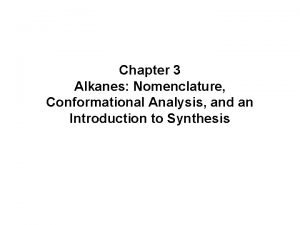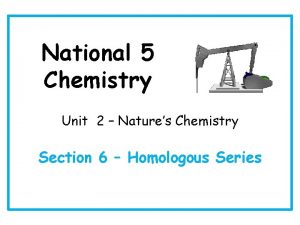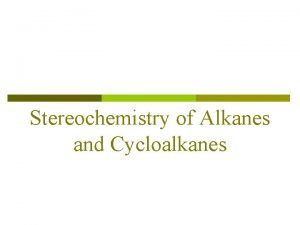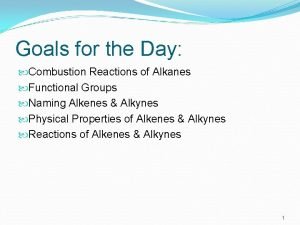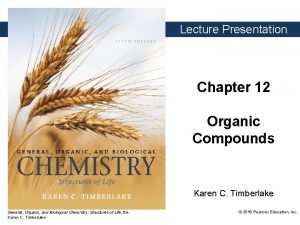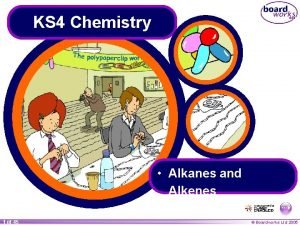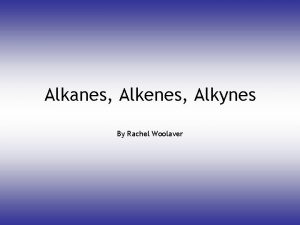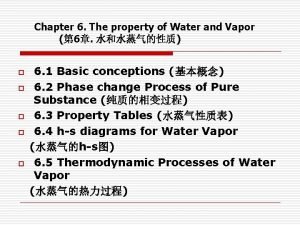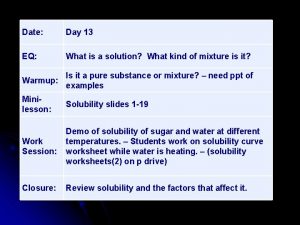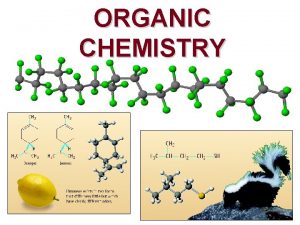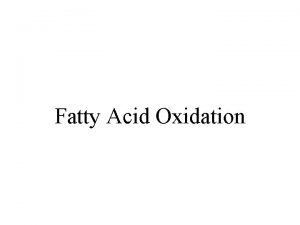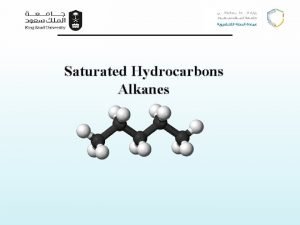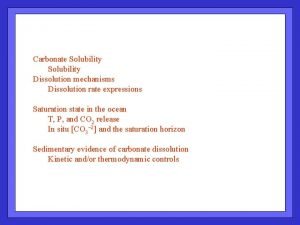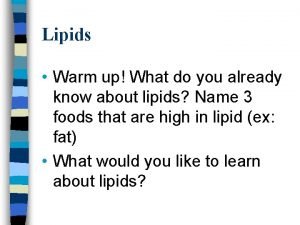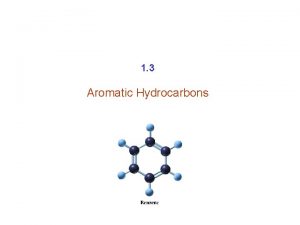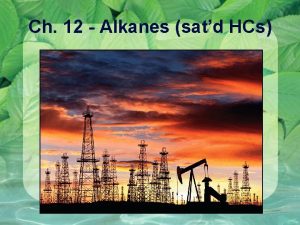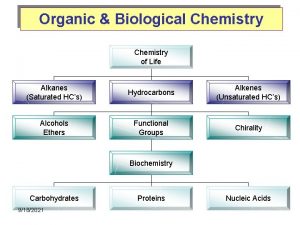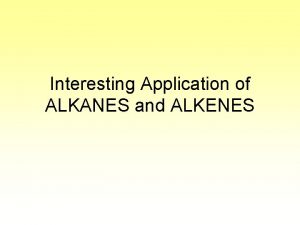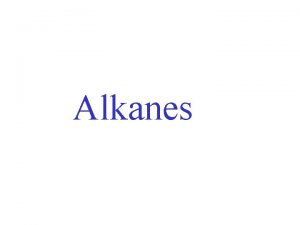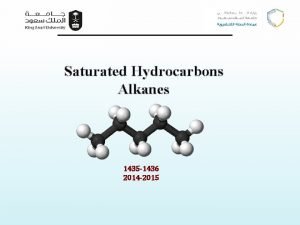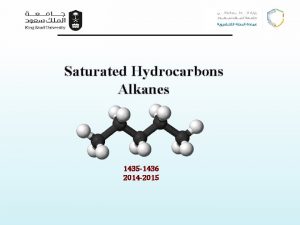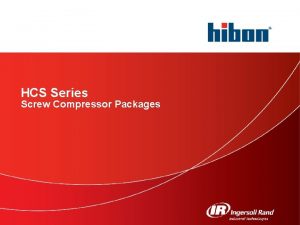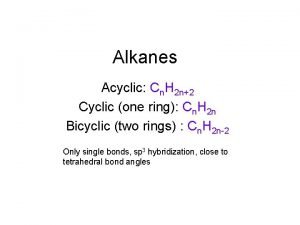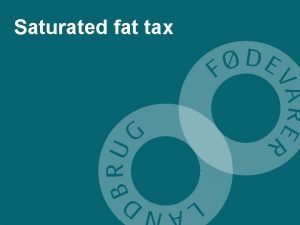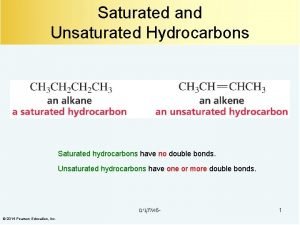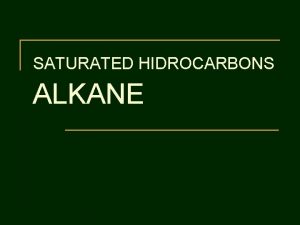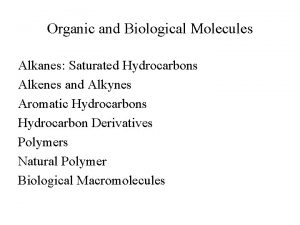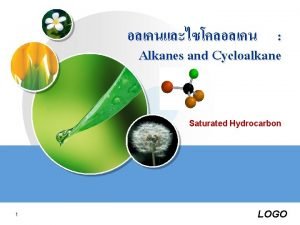Ch 12 Alkanes satd HCs Alkanes Acyclic Saturated










































- Slides: 42

Ch. 12 - Alkanes (sat’d HCs)

Alkanes Acyclic Saturated Hydrocarbons (chains) General Formula: Cn. H 2 n+2 Structural: (ex. : C 4 H 10) Complete Condensed Skeletal Line Angle Decomposition of plant and animal matter in marshes is a good source of methane gas.

Alkane Nomenclature Methane Ethane Propane Butane Pentane Hexane Heptane Octane Nonane Decane

Alkane Isomerism Isomers: compounds that share the same molecular formula but have different structural formulas With an increased number of C atoms, there is an exponentially increased number of isomers Constitutional - same molecular formula, different structural formula; Ex. C 4 H 10 Ex. C 8 H 18 differ in connectivity of atoms butane ; isobutane octane; 3 -methyl heptane

Alkyl Groups & IUPAC names Use the following rules to properly name hydrocarbon molecules: 1. Identify the longest, continuous chain of C atoms and name it (parent C chain and suffix. 2. # the C atoms in the chain from the end nearest an alkyl group. 3. # and name the attached alkyl group(s). 4. If more than one alkyl group: 1 st substituent must have lower number. Alkyl groups are listed in alphabetical order. If two or more identical substituents are bonded, use prefixes to indicate how many 5. Separate #s from each other with commas; separate names from numbers with hyphens; do not use a hyphen/space after the last substituent, before the parent alkane name. Carbons are classified 4 ways in a chain: Primary, secondary, tertiary, quaternary Based on the # of C atoms to which the carbon atom is bonded.

Branched-chain Alkyl Groups “Simple”: 4 important ones to know! Complex: “select the longest chain as the “base” alkyl, add “substituents. ” Ex.

Cycloalkanes

Isomerism of Cycloalkanes Constitutional (ex. : C 5 H 10) 5 isomers Stereoisomers: possible with substituted cycloalkanes (ex. : 1, 2 -Dimethylcyclohexane) Cis- (SAME side) Trans- (ACROSS from)

Sources of Saturated Hydrocarbons Natural Gas: Methane (50 -90%) Ethane (1 -10%) Propane & Butane (up to 8%) Petroleum (crude oil): this is a complex mixture of both cyclic and acyclic hydrocarbons which can be separated by a process known as fractional distillation.

Physical Properties of Hydrocarbons All are insoluble in water Consider the polarity of the compounds Therefore they can make good protective coatings All are less dense than water (0. 6 -0. 8 g/m. L) Oil & water Boiling Points & States of Matter Generally, BP increases with increasing # C atoms Reason: increasing LDF 1 -4 C atoms = gas; 5 -17 C atoms = liquid; >17 C atoms = solid Isomers: Branched BP < Unbranched BP Cyclic Compounds have higher BP than Acyclic.

Chemical Properties of Hydrocarbons Alkanes are the least reactive organic compounds (they have no fcn’l groups). However, two major reactions are common: Combustion R (some hydrocarbon) + O 2 → CO 2 + H 2 O + energy very exothermic reaction. If the quantity of O 2 is insufficient, it will form a poison called carbon monoxide (CO). Here is an example with methane: CH 4 + 2 O 2 → CO 2 + 2 H 2 O with less O 2: 2 CH 4 + 3 O 2 → 2 CO + 4 H 2 O (poison!) with even less O 2: CH 4 + O 2 → C + 2 H 2 O (black soot forms) Halogenation R-H + X 2 --> R-X + H-X

Hydrocarbon fuels Fossil fuels (solid, liquid, or gas) form from organic material being covered by successive layers of sediment over millions of years Oil & natural gas: slow decomposition & burying of marine phytoplankton & zooplankton that sank to the sea floor. Coal: ancient swamps and bogs - slow decomposition of land plants in anaerobic conditions: e. g. peat bogs of Ireland

Petroleum, Naphtha, or crude oil From Greek petra = rock and oleum = oil Thick, dark brown or greenish liquid Complex mixture of various hydrocarbons, largely of the alkane series May vary much in appearance, composition, and purity Petroleum is also the raw material for many chemical products: fuels & solvents Can be altered into: fertilizers, pesticides, and plastics Think of the impact of a substantial oil crisis on our economy & society!

A rock formation such as this is necessary for the accumulation of petroleum and natural gas.

Crude Oil History • 1 st oil wells drilled in China in 4 th century depth up to 800 ft. • Drilled using bits attached to bamboo poles • Burned oil to evaporate brine & produce salt. • 10 th century, bamboo pipelines connected oil wells with salt springs.

Ancient Persian tablets indicate the medicinal and lighting uses lighting of petroleum in the upper society. 8 th century: streets of Baghdad paved with tar. In the 9 th century, oil fields were exploited in Baku, Azerbaijan, to produce naphtha.

Discovery of oil in 1859, near Titusville, Pennsylvania. Great demand for kerosene and oil lamps. Medicinal purposes, lighting, and lubricants for new steam engines. Introduction of internal combustion engine lead to major "oil booms" in Texas, Oklahoma, and California.

The complex hydrocarbon mixture present in petroleum is separated into simpler mixtures by means of a fractionating column. Differences in BPs of hydrocarbon chains can separate out sections of the crude oil: Fractional Distillation

Fuel type Gasoline Mega Joules / Liter 29. 0 Diesel fuel 32. 19 oil Residential 34. 74 heating oil Gasahol 28. 06 10% ethanol 90% gasoline BTU / US gal Research octane # 125, 000 91 to 98 138, 690 N/A 149, 690 N/A 120, 900 93 to 94

Octane: major component of gasoline • Octane is an alkane hydrocarbon: CH 3(CH 2)6 CH 3. • octane isomer: 2, 2, 4 -Trimethylpentane = 100 pts on the octane rating scale • n-heptane is the zero point (greatest engine knocking or “pinging”) • Octane ratings are used to represent antiknock performance (less premature combustion)

Natural gas mainly methane (does contain other “small” HC cpds). Highly flammable No ash and very little air pollution. From light portion of petroleum Rises thru fissures in earth’s crust Man-made wells can tap it Discovered thousands of years ago could be burned for heat and light. Colorless, odorless, & lighter than air. Mercaptan, chemical odorant, is added for gas leaks. natural gas combustion CO 2 + H 2 O Natural gas found in different underground formations: shale, sandstone beds, coal seams, & deep, salt water aquifers

New sources of methane gas: Decomposition of organic matter in landfills CH 4 gas can be tapped instead of vented

3 lakes contain large concentrations of dissolved CO 2 gas. Lake Nyos & Lake Monoun sites of gas explosions: 40 dead at Monoun & 1800 at Nyos 3 rd lake is Kivu, which contains a 1, 000 x more gas than Lake Nyos. Kivu Lake

Coal formation • Vegetable matter accrues • Prevented from decay • Forms peat beds. • Over time: buried & compressed, forms lignite. Increased P & T makes bituminous • At great depths, high temps reduce CH 4 & forms anthracite (very high in C) coal (higher C content).

Fossil Fuel “Facts” Current Consumption? What about as China and India modernize? These countries have 33% of world population! Source: Shell Oil The U. S. has 4% of the World's population. The U. S. uses 34% of Earth's natural resources.

U. S. Sources of Energy Production Fossil Fuels 86% Geothermal 0. 5% Nuclear 8% Wind Farms 0. 1% Hydroelectric 2% Solar 0. 1% Biofuels 3. 3% source: US Dept of Energy Enormous dependence on a limited resource. Other alternatives? -Wave energy -Tidal energy -New technology for solar panels, turbines, etc. -Conservation!! -Efficiency!!! Remember that, while hydrocarbons serve as a transportation fuel, they are also used to produce plastics, etc.

Problems associated with alkane hydrocarbons Hydrocarbon pollution: (oil spills) of aquatic environments (e. g. BP in the Gulf of Mexico) Global warming: CO 2 and H 2 O Acid rain due to sulfur impurities in oil and coal: damage crops, lakes, buildings, etc. Smog and soot: increase respiratory problems Land fill: non-decomposing plastics Ozone depletion / increased UV radiation

Accidental & Purposeful Oil Spills Clean-up takes into account density and non-polar nature

Global warming: The Greenhouse effect: Short wavelength solar radiation releases energy as it hits molecules. Turns into long wavelength energy. Gases in atmosphere trap it and warm the atmosphere.

Arctic ice sheet 1979 and 2000 CO 2 increase correlates to average global temperature increase Can cause: changes in sea level, reduction of reflective ice caps, increased storm ferocity, plant & animal re-distribution, shift ocean currents, create droughts & forest fires, increased short-term temperature fluctuations.

Alkane substitution reaction: Incoming atom or group of atoms (orange sphere) replaces a hydrogen atom in the alkane model. Naming: Treat halogen atoms like alkyl groups. F = fluoro; Cl = chloro; Br = bromo; I = iodo Ex. : CH 3 -CHBr-CHI-CH 2 -CH 3

Halogenation Reactions General equation: RH + X 2 → RX + HX Hydrocarbon + Halogenated + acid (diatomic) hydrocarbon Ex. CH 4 + Cl 2 --> CH 3 Cl + HCl Highly exothermic reaction: can lead to an explosion

The process can continue to alter the resulting products as long as the halogen remains in sufficient quantities to drive further reactions. (The halogen would be the _____ reactant. )

Space-filling models of the four ethyl halides. Do these molecules act as polar or non-polar?

Chlorofluorocarbons (CFCs) Developed in the 1930's Very stable compounds composed of C, F, Cl, & H Freon is the tradename: Trichlorofluoromethane Dichlorodifluoromethane Trichloro-trifluoroethane Dichloro-tetrfluoroethane Chloropentafluoroethane

Safe, non-toxic, non-flammable alternative to dangerous substances (e. g. ammonia) for aerosol-spray propellants, refrigerants, solvents, and foam-blowing agents

CFCs and refrigeration CFCs and propellants

UV radiation in the stratosphere

The Ozone Layer Chemistry CFCl 3 + UV Light ==> CFCl UV Light 2 + Cl + O 3 ==> Cl. O + O 2 Cl. O + O ==> Cl + O 2 The chlorine free radical atom is then able to attack another ozone molecule Cl + O 3 ==> Cl. O + O 2 Cl. O + O ==> Cl + O 2 and again. . . thousands of times! A catalyst!

The ozone destruction process requires conditions cold enough (-80 o. C) for stratospheric clouds to form. Once these stratospheric clouds form the process can take place, even in warmer conditions

Ozone consumption has been greatly reduced, however CFCs may linger for another 150 years in the atmosphere 1997 ozone hole 2003 ozone hole Ozone layer thickness

What do you need to know (about saturated hydrocarbons)? Structural characteristics (know the functional group) Substituents Nomenclature (the rules for naming the molecules) Physical and Chemical properties (basic/simple) Occurrence and uses (common) Preparation (what basic reactions produce the molecules) Characteristic reactions of the molecules
 A vertex is if its indgree(v)=1 and outdegree(v)=0.
A vertex is if its indgree(v)=1 and outdegree(v)=0. Local markov assumption
Local markov assumption Connected acyclic graph
Connected acyclic graph Acyclic dependencies principle
Acyclic dependencies principle Hosted collaboration solution
Hosted collaboration solution Sci compartments si/tk/g/hcs
Sci compartments si/tk/g/hcs Hcs algorithm
Hcs algorithm Classworks.manager.hcs
Classworks.manager.hcs Hcs classlink
Hcs classlink Relative stability of isomeric alkanes
Relative stability of isomeric alkanes Alkanes list
Alkanes list Alkanes list
Alkanes list Organic chemistry iupac name
Organic chemistry iupac name Covalently def
Covalently def Alkyl substituents
Alkyl substituents Sources of alkanes
Sources of alkanes Alcohol ir spectrum
Alcohol ir spectrum General formula for alkyl group
General formula for alkyl group Alkane formula
Alkane formula Alkylation of alkanes
Alkylation of alkanes Shortened structural formula
Shortened structural formula Ethane
Ethane Combustion reaction of alkanes
Combustion reaction of alkanes Applications of alkanes
Applications of alkanes Viscosity marble experiment
Viscosity marble experiment Uses of alkanes
Uses of alkanes Alkanes alkenes alkynes
Alkanes alkenes alkynes Test for alkenes
Test for alkenes Alkanes combustion
Alkanes combustion Alkanes solubility
Alkanes solubility Saturated liquid line
Saturated liquid line Solubility curve saturated unsaturated supersaturated
Solubility curve saturated unsaturated supersaturated Saturated hydrocarbon
Saturated hydrocarbon Saturated fatty acids definition
Saturated fatty acids definition Is alkane saturated
Is alkane saturated Solubility curve saturated unsaturated supersaturated
Solubility curve saturated unsaturated supersaturated Saturated
Saturated Saturated adiabatic lapse rate
Saturated adiabatic lapse rate Venn diagram saturated and unsaturated fats
Venn diagram saturated and unsaturated fats Solubility curve
Solubility curve Benzene with oh group
Benzene with oh group Food rich in nucleic acid
Food rich in nucleic acid Saturated flow of water in soil
Saturated flow of water in soil
